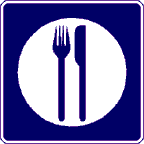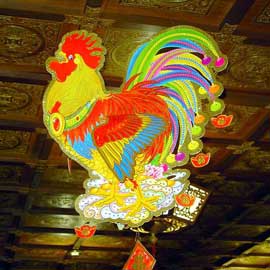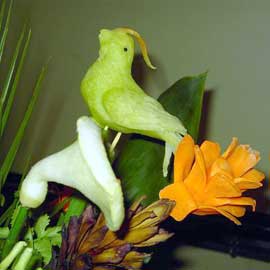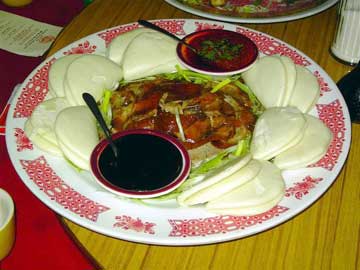Lunar Chinese Banquets | ||
| Chinese Cultural and Community Center 125 North 10th Street (215) 923-6767 (BY ADVANCE RESERVATION ONLY) Through May 15, 2005
The cooks come from the “4-star” Tibet Hotel in Chengdu, Sichuan Province near the campestral Tibetan border. So “4-star” may be an astrologer’s linguistic accolade rather than an astronomer’s. Let me be frank. The Center is worn, linoleum-floored, cold and gaunt in spots. English is spoken diffidently, but not without confidence. The evening is really such a success because of the unfailing quaintness and kind remarks of your hostess Victoria Van Chang, the pampered portions of authentic creations, and the extremely lazy-Susan method of food distribution. Each large round table seats twelve to which you are given a pre-assigned seat. Meeting and sharing with friendly tourists and neighbors from Philadelphia’s plethora of neighborhoods, adds to the joy. The spectacle does not allow for silence, nor lacks of laughter.
I adore the “Kong Long Egg Plant,” a mysteriously dark and sinister sauce in which are floating eggplant chunks next to immersed diced dried cod. The purple and green vegetables are cool to the tongue and easy to squash between teeth; while the cod nodules add a momentary crispness leading to tractable tartness. And then the sauce hits the inside of your nasal passage with a smoky peppered blast. It’s what Sichuan cuisine is calculated to create. Tablemates titter and tear. Likewise, the Mt. E-Mai Spicy Beef creates a startling stir of tonsils. Skirt steak is served in an opaque red-tinged broth. Shredded beef plunges into your mouth and rests, to be chewed. A fire begins in the cheek nearest to the meat, and spreads as you swallow, lingering like embers at your larynx. An implanted defibrillator goes off in a man at another table. His wife is from Montana, so she hotly tells him to “shake it off.” There’s also Chengdu Hot Pot, a chicken and fish based soup whose non-liquid ingredients include long faux-crab slices, round fish balls (as if they were matzoh), ham and mushrooms. The concoction appears burbling in a mammoth silver tureen still aflame from below. These contents cool your palate.
There are plentiful offerings of crispy corn-starch coated shrimp (“Huang Long”), sizzling chicken (“Jiu Zai”) and vegetable sticks (“Panda Veggies”) whose tastes are not unfamiliar in Chinatown. Everyone sighs as less pungent and heated flavors flow across their lips. No one grabs for the icy water pitcher, attempting to roundly swing Susan at warp speeds. The meal’s highlight, if you still have room, is a whole fresh fish in a sweetly sour sauce whose fleshy innards have been (almost) boned, shaped morsel-size, sautéed with saffron, fried and implanted back into the fish platter between the plated fish’s dull-eyed head and chopped off tail. It is named “Tibetan Red Flower Sea Bass.” The red flower alludes to the saffron. Chinese proverb: The longer the name for fish menu item, the longer the lingering fishy aftertaste. Enough said. “Kang Din Sweet Heart” concludes the banquet as dessert. Hearts may be shaped differently in Chengdu than almost anywhere else, because the ventricle at issue is certainly not where it ought to be. But the mushy brown-sugared pie-pudding mold’s muted sweetness grows on you, and washes down well with amber tea. T.T. Chang, who hailed from Hangzhou, China, created the Center in 1955 as a small YMCA. His interests in cooking provided the incentive, about 25 years ago, to bring chefs to Philadelphia from various Chinese provinces. His wife is enamored of his memory, as she should be. The banquets are legendary, entertaining, different and delightful. Don’t take the slow boat to make your reservation. E FLAMMA PETERE CIBUM | ||
| Copyright 2005 Richard Max Bockol, Esq. | Back | |



 Sichuan master-chef Jiang Guo Fu takes a knife to an onion and converts the latter into a Dahlia; or he shapes a huge radish into an orange parakeet. Gongs ring around the new year of the Rooster (4703), in conjunction with the Chinese Cultural Center’s 50th anniversary. Fu is here making culinary magic, along with chef Guo Zhi Hua, and with assistants Yuan Kai Cao and Ben Zhen Wang. The coterie prepares belly-filling ten-course banquets nightly at 6:30 p.m. ($32; Fri through Sunday $35).
Sichuan master-chef Jiang Guo Fu takes a knife to an onion and converts the latter into a Dahlia; or he shapes a huge radish into an orange parakeet. Gongs ring around the new year of the Rooster (4703), in conjunction with the Chinese Cultural Center’s 50th anniversary. Fu is here making culinary magic, along with chef Guo Zhi Hua, and with assistants Yuan Kai Cao and Ben Zhen Wang. The coterie prepares belly-filling ten-course banquets nightly at 6:30 p.m. ($32; Fri through Sunday $35). But you may have to (1) keep your coat on a while, as the drafts are frigid through March; (2) bring your own wine and wine glass; (3) sit hungrily but respectfully through a twenty-minute drum-riddled film travelogue of Tibet; and (4) wonder whether anyone will clear tables or offer new clean dishes after the sixth course.
But you may have to (1) keep your coat on a while, as the drafts are frigid through March; (2) bring your own wine and wine glass; (3) sit hungrily but respectfully through a twenty-minute drum-riddled film travelogue of Tibet; and (4) wonder whether anyone will clear tables or offer new clean dishes after the sixth course. Sliced rendered and roasted Red Palace Roast Duck is provided on a platter among hoisin sauce, crushed and oiled Sichuan peppercorns, and three-inch round yeasty buns, to make a sandwich. The duck breast is dark and golden-edged, with a satin texture emboldened by the condiments. The bun encloses the deal.
Sliced rendered and roasted Red Palace Roast Duck is provided on a platter among hoisin sauce, crushed and oiled Sichuan peppercorns, and three-inch round yeasty buns, to make a sandwich. The duck breast is dark and golden-edged, with a satin texture emboldened by the condiments. The bun encloses the deal.